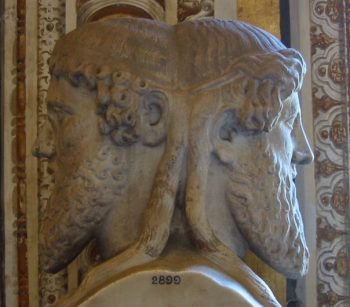Janus: Gates to the Past and the Future Posted by Brittany Britanniae on Jan 11, 2017 in Roman culture, Uncategorized
Salevete Omnes! Right now, as the new year kicks back into full swing a lot of us are probably thinking about what the new year has to offer. We are thinking about time; the time ahead of us and the time that has just passed. As we reflect on 2016 we are all looking forward to 2017. The Ancient Romans also considered the past and present like this at the beginnings of new years, in fact, they had a god dedicated to the juxtaposition of the past, present, and the movement through time.
If you are a Classics enthusiast you may have already easily recognized the theme of today’s post and have seen the likeness of the god above Difficult to forget, this god, called Janus, was envisioned as a man with two faces on his head. The significance of these two faces was not the form of the god but the symbolism of being able to perceive was it both before yourself and behind yourself. The Ancient Romans took this abstraction to the next level and linked this with the perception of time.
Janus was regarded as the god of beginnings and transitions and this month, January, was named after him. He had his festival on January 9th, which has just passed us. It was called the Agonium and was usually observed with the sacrifice of a ram. Janus has his two sets of eyes gazing intently on the future ahead of him and on the past that he is leaving behind. Interestingly, the attention that this god gives to the immovable past and the mysterious future would make one think that he has little place in the transient presence, but there is another surprising affiliation for this god.
Janus is also affiliated with gates. Gates, in a symbolic sense, are doorways from the past to the future. Janus, a being who is transfixed by what is behind him and in front of him is an apposite match for the symbolism of a gate.
The Ancient Romans had many Jani (plural of Janus) positioned all over Rome. These were ceremonial entrances gates. You may think of certain other modern gates erected in major cities after triumphs. This would be yet another inherited tradition from the Romans. The Romans particularly placed importance on how an army would pass through these gates when they were leaving.
For the Romans, passing through these Jani was an auspicious recognition of a change. These gates, although they were not connected to walls and could be easily walked around in order for a person to reach their destination, were symbolically significant. There were even lucky and unlucky ways for someone to walk through the gateway.
The most famous gateway was the Janus Geminus. When the empire was strong it was a shrine to the god Janus at the north side of the Forum. It was a simple and bare structure that featured bronze doors at either end. Sadly, no remains of this structure has survived to the present day. It was a tradition for the Roman to keep the doors closed in times of peace, when armies did not have to travel through them. In Livy’s histories this only happened twice in his account of the time during the period between Numa Pompilius (7th century bc) and Augustus (1st century bc).
Nero, after the disastisfying end of the Parthian campaign, ordered the construction of a Neronian Janus that was meant to commemorate the peace. The procession passed through this gates and on them the inscription:
” PACE P R TERRA MARIQ PARTA IANVM CLVSIT”
“The Peace of the Roman People having been established on Land and Sea, he closed Janus.”
The doors were closed, to represent the peace and to signify the stability of peace which did not need lucky beginnings or transitions. However, the doors would not stay closed for very long and were reopened in 66 CE for the Jewish wars, asking, once again, for Janus’ blessing as the Romans faced an uncertain future.

Build vocabulary, practice pronunciation, and more with Transparent Language Online. Available anytime, anywhere, on any device.







